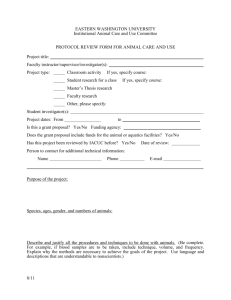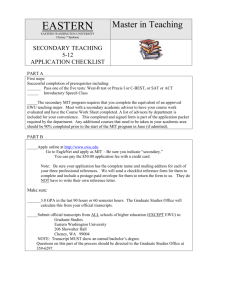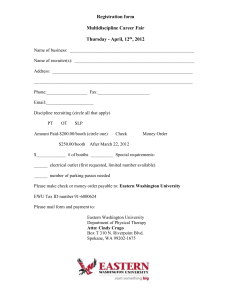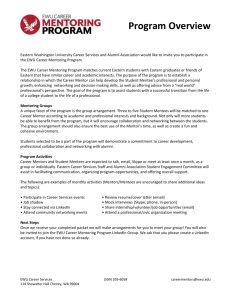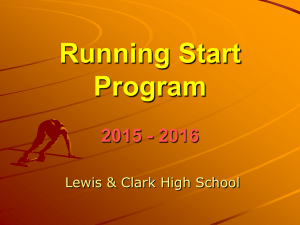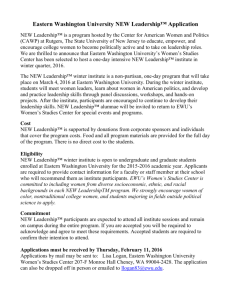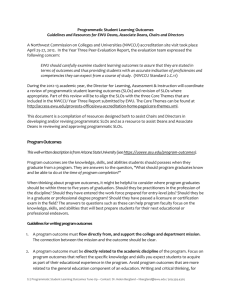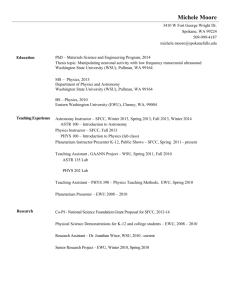October 31, 2012
advertisement
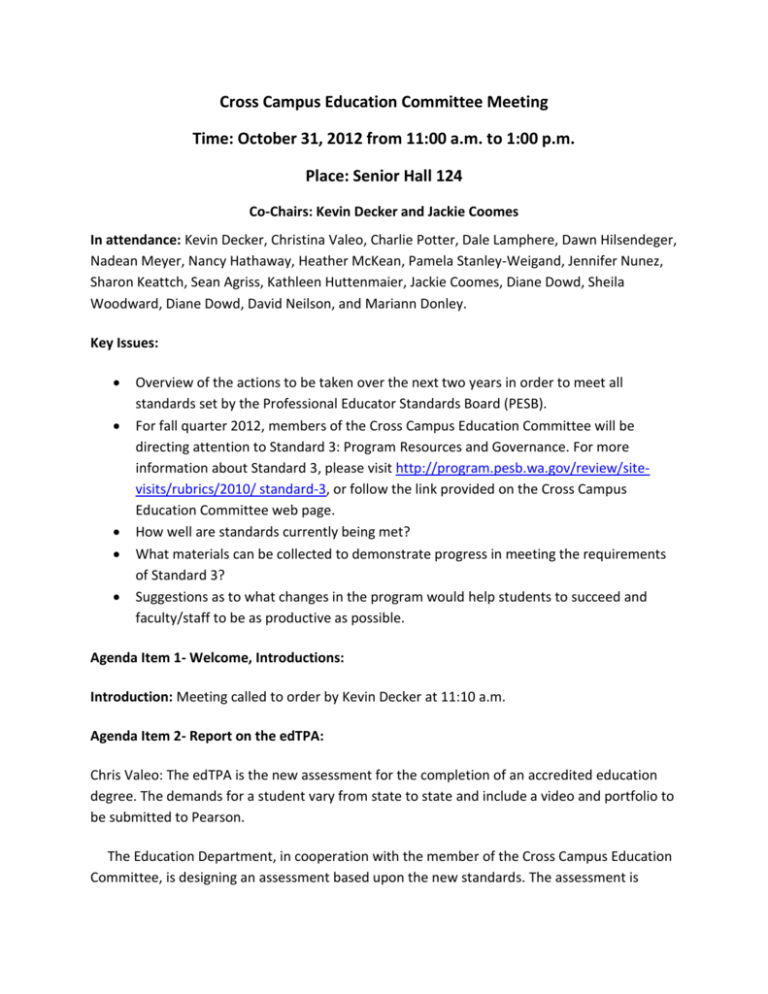
Cross Campus Education Committee Meeting Time: October 31, 2012 from 11:00 a.m. to 1:00 p.m. Place: Senior Hall 124 Co-Chairs: Kevin Decker and Jackie Coomes In attendance: Kevin Decker, Christina Valeo, Charlie Potter, Dale Lamphere, Dawn Hilsendeger, Nadean Meyer, Nancy Hathaway, Heather McKean, Pamela Stanley-Weigand, Jennifer Nunez, Sharon Keattch, Sean Agriss, Kathleen Huttenmaier, Jackie Coomes, Diane Dowd, Sheila Woodward, Diane Dowd, David Neilson, and Mariann Donley. Key Issues: Overview of the actions to be taken over the next two years in order to meet all standards set by the Professional Educator Standards Board (PESB). For fall quarter 2012, members of the Cross Campus Education Committee will be directing attention to Standard 3: Program Resources and Governance. For more information about Standard 3, please visit http://program.pesb.wa.gov/review/sitevisits/rubrics/2010/ standard-3, or follow the link provided on the Cross Campus Education Committee web page. How well are standards currently being met? What materials can be collected to demonstrate progress in meeting the requirements of Standard 3? Suggestions as to what changes in the program would help students to succeed and faculty/staff to be as productive as possible. Agenda Item 1- Welcome, Introductions: Introduction: Meeting called to order by Kevin Decker at 11:10 a.m. Agenda Item 2- Report on the edTPA: Chris Valeo: The edTPA is the new assessment for the completion of an accredited education degree. The demands for a student vary from state to state and include a video and portfolio to be submitted to Pearson. The Education Department, in cooperation with the member of the Cross Campus Education Committee, is designing an assessment based upon the new standards. The assessment is currently in field-test mode and has been in place for about one year. All candidates must complete the assessment. The Pedagogical assessment has been eliminated in place of the new standards. A 5-point scale has been established. If a student is rated at 3, they are average in regards to what is expected of a beginning teacher. If they are rated at 1 or 2 they are below average, if they are rated at 4 they are above average and if they are rated at a 5 they are excelled. The exact value of each rating has not yet been firmly established. Dale Lamphere: Dale has been assigned to monitor the new standards. Pearson has recently changed the handbooks and added new rubrics specific to Business Education and Special Education. There is now a total of 18 rubrics in the handbook. Dale has put together a handout which reflects the assessment results of EWU students compared to state and national averages. There are five levels which a student can receive based upon the 5-point scale, and four tasks to be completed. Task 1 concerns planning, task 2 concerns student engagement, task 3 concerns assessment, and task 4 concerns reflection. Task 4 is being phased out and incorporated into the other tasks. Please note that student voice is unique to the state of Washington. Page 1 of the handout provided by Dale shows how EWU scored students compared to how Pearson scored students. Page 2 provides the averages gathered by Pearson, organized by rubric. On page 3, Dale discusses a new edTPA website which will be open to the public. Pages 3, 4 and 5 show the figures gathered by Dale of the success of EWU students on the assessment. For task 1, EWU had a higher percentage of students rated at level 2 (below average) than the state and national percentages reflect. For task 2, with a rating of level 2, EWU meets the average of the state and is below the national average. For task 3, with a rating of level 2, EWU scored above the state average and below the national average. For task 4, with a rating of level 2, EWU met the state average and is below the national average. For academic language, with a rating of level 2, EWU students are above the state average and below the national average. For student voice, EWU students are above the state average (the national average is not applicable as Washington is the only state to address student voice). EWU demonstrated a trend of being above the state and national averages for students who were rated at level 3 (average) for tasks 1, 2, 3, and 4, as well as academic language and student voice. For task 1, with a rating of levels 4 and 5 (above average and excelled), EWU students are below the state and national averages. For task 2, with a rating of levels 4 and 5, EWU students are below the state average and above the national average. For task 3, with a rating of levels 4 and 5, EWU students are below the state average and tied with the national average. For task 4, with a rating of levels 4 and 5, EWU students below both state and national averages. For academic language, with a rating of levels 4 and 5, EWU is below the state average and above the national average. For student voice, with a rating of levels 4 and 5, EWU is below the state average (the national average is not applicable as Washington is the only state to address student voice). The goal of EWU faculty, staff and students is to lower the percentage of students receiving ratings of 1 or 2, and to increase the percentage of students receiving a rating of 3, 4, or 5. As of right now, when Pearson reviews a student they will provide the scores without commentary. In order to improve student success rates, templates will be made available for the assessments each program will provide. The handbook will be made readily accessible to the students so they will understand what is expected of them. There are several suggestions as to how students can be aided to improve their scores. One suggestion is the introduction of a quarter system so that students may have a deeper study (this is being weighed against the diversified education the quarter system provides). Another suggestion is to lengthen the student teacher practicum as EWU currently has the shortest practicum in Washington State. As part of the solution, EWU faculty have begun working to ensure that each program’s content is aligned with the assessment. Additionally, a mandatory seminar will be introduced for teaching candidates; there are about 75 candidates student teaching while about 25 currently attend seminars. Candidates need to clearly describe the learning environment and diversity within the classroom, along with how they will be sure to meet all needs. Overall, the learning environment created by EWU teaching candidates provided strong emotional support, but was weak in content; perhaps due to lack of instruction in a particular area. This could be attributed to candidates entering into an unfamiliar situation without enough time to learn. Students will learn one method, and then be moved to another school. These were general observations that helped Pearson and Stanford to make the changes they made. Students commonly need to provide further information regarding their projects and need to be sure to address all prompts. Additionally, the video is very important and students should be sure to reflect upon their learning experience. Agenda Item 3- Syllabi Collection: Kevin Decker: Each quarter, all offered courses which are part of an endorsement program will need to provide a syllabus. Chris Valeo: It would be easiest if teachers could just send digital copies at the beginning of the quarter. The syllabi can be sent to Charlie Potter at cpotter@ewu.edu, or Maxine Holden at mholden50@ewu.edu. Pamela Stanley-Weigand: To aid the instructors, many of the department secretaries can monitor the course list and syllabi (the department secretaries often have a copy of the syllabi on hand). Agenda Item 4- West-E: Charlie Potter: Each department will have a unique West-E, formatted to their program. If you have any questions regarding the West-E, please contact Charlie at cpotter@ewu.edu. Agenda Item 5- Program Revision: Dawn Hilsendeger: There are several changes which the Education Department is currently undergoing. These include: aligning programs with the corresponding end assessment, ensuring that students are able to graduate on time, candidate placement and revision of the admission process. Over the course of their degree, students will sometimes get off track and elongate their time in school. One of the best ways to mend this issue is to ensure that advisors are informed and readily available to help students; furthermore, students need to ask for help when they are unsure of what course to follow. One of the largest changes the Education Department is undergoing is the implementation of a deadline for admittance to the program. People will often come to the Education Department the same quarter they would like to begin taking classes. Oftentimes students will not be prepared. Another issue is that students will come to education because they were denied admittance to another program, rather than coming to education because they want to teach. The institution of a deadline would ensure that students who apply to education are interested in pursuing the degree, as well as demonstrating that they are responsible enough to complete paperwork and turn it in on time. This would further help to ensure that resources go to students who are dedicated and desire to pursue education as a career. EDUC 200 and EDUC 201 will be acceptable prerequisites. The Education Department is also working to improve the placement of candidates. There are several candidates to place, and teachers are often concerned about mentoring a student teacher as they fear losing control of the class. Fearing that they will miss their appointment quarter and delay graduation, candidates might seek their own placement. This then poses an issue not only for them, but for other students who have been waiting a placement given by the Education Department. Chris Valeo: It is not credible for students when they find their own placement, nor does the state approve. One of our goals is to find how each student can be placed on time, and all state requirements can be met. Jackie Coomes: Finding a teacher who is skilled and willing to help is essential for student success. It would be helpful to emphasize the co-teaching method so that more local teachers would be willing to mentor candidates. If teachers are more readily available, students would not need to wait as long for an appointment and would not seek an appointment on their own. Another solution might be to have more than one student teacher in a classroom. Research has indicated that more than one student teacher can be very effective. Diane Dowd: If it were possible, instructors could call people they know from local schools to inform them of the strengths of a given candidate and why they would be a good fit for the classroom. This would not only help with the process of placing students (Sherry in the Education Department would need to be informed of all potential placements), but it would help students to be placed with the teachers with the closest disposition. Agenda Item 6- Professional Expectations/Dispositions: Jackie Coomes: We should all keep in mind what we expect of our students by the time of their graduation. This will help throughout the instruction of the student, as well as finding the proper placement. Mariann Donley: When a student is completing their student teaching appointment, the mentor teacher is provided a Disposition Form (can be viewed on the cross campus website). The mentor teacher is able to provide feedback regarding the performance of the student teacher. When a skill is indicated as ‘developing,’ the teacher can be contacted to enquire as to how the candidate could improve. Often, teaching candidates do not know there is a problem until they are in the classroom. Diane Dowd: Many issues could perhaps be prevented if they are noticed by a student’s instructor and addressed before the student begins their teaching practicum. Sean Agriss: Feedback from the endorsement areas can be increased. Agenda Item 7- Alignment: All endorsement programs are currently undergoing changes in order to ensure that the course materials are aligned with the final assessments. The final assessments are not yet finalized. Agenda Item 8- Accreditation: Chris Valeo: The Education Department is undergoing a two year self-study, in cooperation with the endorsement areas, to ensure that all accreditation standards are met. In particular, EWU will be focusing on Standard 4.3b. During fall 2012, focus will be upon Standard 3: Program Resources and Governance. During winter 2013, focus will be upon Standard 4: Program Design. During spring 2013, focus will be upon Standard 5: Program Review and Certification. During fall 2013, focus will be upon Standard 2: Accountability and Program Improvement. In winter 2014 the data collected will be synthesized, and in spring 2014 a thorough self-study will be conducted. By fall 2013, Standard 2 can be more thoroughly investigated as Charlie Potter is currently developing a data-collection system which will be open to permitted parties. Standard 1 is addressed by the Professional Educators Advisory Board (PEAB). Local educators and EWU faculty/staff meet quarterly. The communication between PEAB and EWU faculty/staff can be improved to help meet the standards. In 2015, the state will offer accreditation based on efforts and evidence. Agenda Item 9- Family-Friendly Curriculum Center and iPAD Education Methods: Nadean Meyer: The curriculum center has now been made family friendly for students, faculty and staff with children. The library has introduced a new program which provides iPADS for students and allows them to download education apps. There are now 130 eBooks available. Many of the books have features such as a searchable PDF function or the ability to read-aloud. These eBooks can be accessed at http://www.mackin.com/VIA. If you would like to know more, contact Nadean Meyer at nmeyer@ewu.edu. Conclusion: For a detailed explanation of what individuals and departments can provide to aid in data collection, a sheet has been provided by Charlie Potter. This sheet of tasks is available on the Cross Campus Education Committee Website. Where are we now in regards to meeting requirements? What evidence can be provided? Where do we want to be by the end of these two years? What evidence would be needed?
